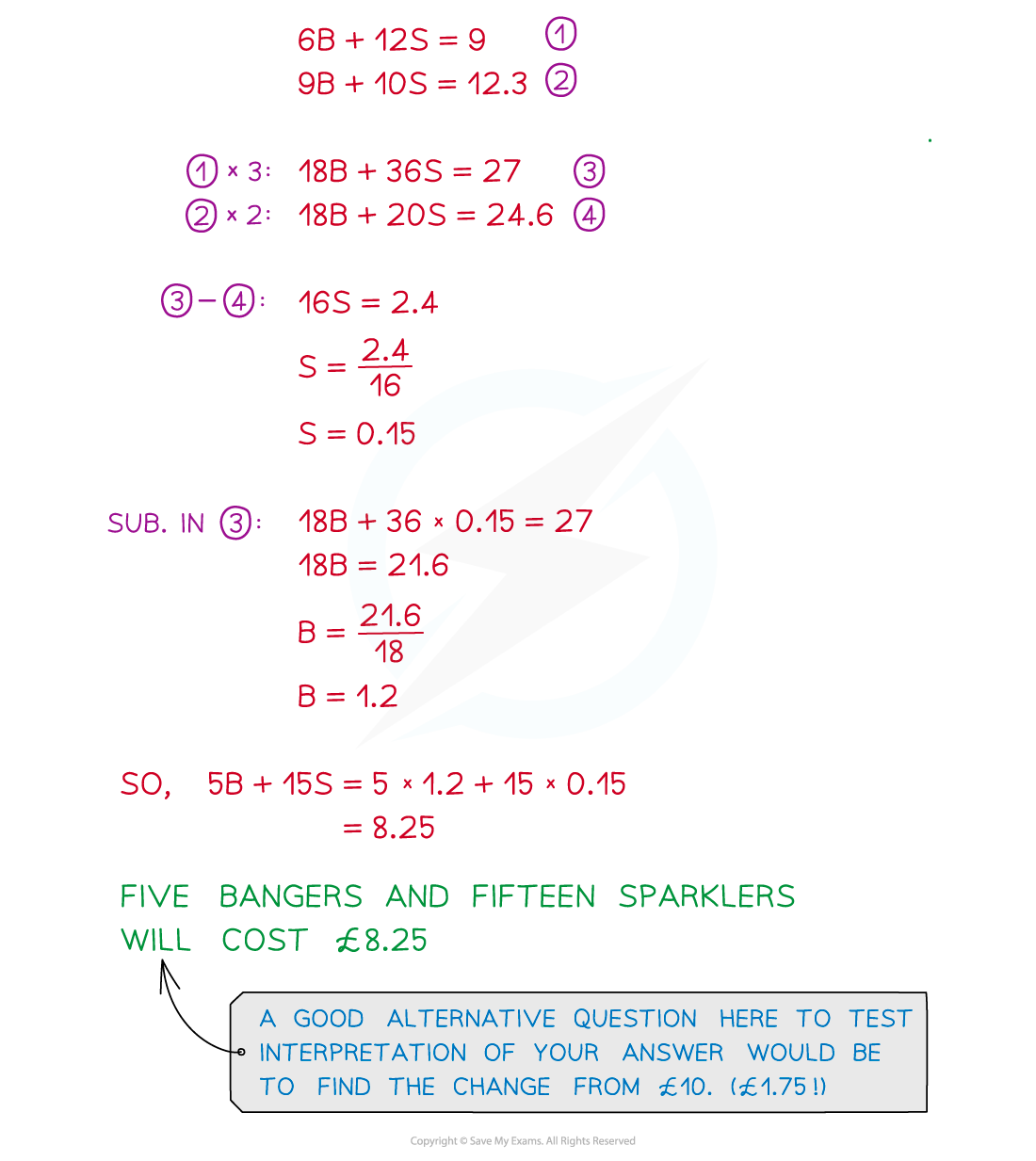Simultaneous Equations (Edexcel IGCSE Further Pure Maths) : Revision Note
Linear Simultaneous Equations
What are linear simultaneous equations?
When there are two unknowns (say x and y) in a problem, we need two equations to be able to find them both: these are called simultaneous equations
you solve two equations to find two unknowns, x and y
for example, 3x + 2y = 11 and 2x - y = 5
the solutions are x = 3 and y = 1
If they just have x and y in them (no x2 or y2 or xy etc) then they are linear simultaneous equations
How do I solve linear simultaneous equations by elimination?
"Elimination" completely removes one of the variables, x or y
To eliminate the x's from 3x + 2y = 11 and 2x - y = 5
Multiply every term in the first equation by 2
6x + 4y = 22
Multiply every term in the second equation by 3
6x - 3y = 15
Subtract the second result from the first to eliminate the 6x's
leaving 4y - (-3y) = 22 - 15, i.e. 7y = 7
Solve to find y (y = 1) then substitute y = 1 back into either original equation to find x (x = 3)
Alternatively, to eliminate the y's from 3x + 2y = 11 and 2x - y = 5
Multiply every term in the second equation by 2
4x - 2y = 10
Add this result to the first equation to eliminate the 2y's (as 2y + (-2y) = 0)
The process then continues as above
Check that your final solutions satisfy both equations
How do I solve linear simultaneous equations by substitution?
"Substitution" means substituting one equation into the other
Solve 3x + 2y = 11 and 2x - y = 5 by substitution
Rearrange one of the equation into y = ... (or x = ...)
For example, the second equation becomes y = 2x - 5
Substitute this into the first equation (replace all y's with 2x - 5 in brackets)
3x + 2(2x - 5) = 11
Solve this equation to find x (x = 3), then substitute x = 3 into y = 2x - 5 to find y (y = 1)
Check that your final solutions satisfy both equations
How do I use graphs to solve linear simultaneous equations?
Plot both equations on the same set of axes
to do this, you can use a table of values or rearrange into y = mx + c if that helps
Find where the lines intersect (cross over)
The x and y solutions to the simultaneous equations are the x- and y-coordinates of the point of intersection
e.g. to solve 2x - y = 3 and 3x + y = 7 simultaneously, first plot them both (see graph)
find the point of intersection, (2, 1)
the solution is x = 2 and y = 1

How do I solve linear simultaneous equations from worded contexts?


Examiner Tips and Tricks
Always check that your final solutions satisfy the original simultaneous equations - you will know immediately if you've got the right solutions or not.
Worked Example
Solve the simultaneous equations
Number the equations.
Make the y terms equal by multiplying all parts of equation (1) by 3 and all parts of equation (2) by 2.
This will give two 6y terms with different signs. The question could also be done by making the x terms equal by multiplying all parts of equation (1) by 4 and all parts of equation (2) by 5, and subtracting the equations.
The 6y terms have different signs, so they can be eliminated by adding equation (4) to equation (3).
Solve the equation to find x by dividing both sides by 23.
Substitute x = 3 into either of the two original equations.
Solve this equation to find y.
Substitute x = 3 and y = - 2 into the other equation to check that they are correct
Quadratic Simultaneous Equations
What are quadratic simultaneous equations?
When there are two unknowns (say x and y ) in a problem, we need two equations to be able to find them both: these are called simultaneous equations
If there is an x2 or y2 or xy in one of the equations then they are quadratic (or non-linear) simultaneous equations
How do I solve quadratic simultaneous equations?
Use the method of substitution
Substitute the linear equation, y = ... (or x = ...), into the quadratic equation
Do not try to substitute the quadratic equation into the linear equation
For example solve x2 + y2 = 25 and y - 2x = 5
Rearrange the linear equation into y = 2x + 5
Substitute this into the quadratic equation, replacing all y's with (2x + 5) in brackets
x2 + (2x + 5)2 = 25
Expand and solve this quadratic equation (x = 0 and x = -4)
Substitute each value of x into the linear equation, y = 2x + 5, to get their value of y
Present your solutions in a way that makes it obvious which x belongs to which y
x = 0, y = 5 or x = -4, y = -3
Check that your final solutions satisfy both equations
How do you use graphs to solve quadratic simultaneous equations?
Plot both equations on the same set of axes
to do this, you can use a table of values (or, for straight lines, rearrange into y = mx + c if it helps)
Find where the lines intersect (cross over)
The x and y solutions to the simultaneous equations are the x- and y-coordinates of the point of intersection
e.g. to solve y = x2 + 3x + 1 and y = 2x + 1 simultaneously, first plot them both (see graph)
find the points of intersection, (-1, -1) and (0, 1)
the solutions are x = -1 and y = -1, or x = 0 and y = 1

Examiner Tips and Tricks
If the quadratic resulting from substitution has
a repeated root, then the line is a tangent to the curve
no roots, then the line does not intersect with the curve – or you have made a mistake!
When giving your final answer, make sure you indicate which x and y values go together
If you don’t make this clear you can lose marks for an otherwise correct answer.
Don't make the common mistake of thinking each squared term in x2 + y2 = 25 can be square-rooted to give x + y = 5
They can't, the most you can do is
But you shouldn't be trying to make x or y the subject of this anyway!)
Worked Example
Solve the equations
Number the equations.
There is one quadratic equation and one linear equation so this must be done by substitution.
Equation (2) is equal to so this can be eliminated by substituting it into the
part for equation (1).
Substitute into equation (1).
Expand the brackets, remember that a bracket squared should be treated the same as double brackets.
Simplify.
Rearrange to form a quadratic equation that is equal to zero.
Both terms contain a power of
So this can be factorised by taking out a common factor of .
Solve to find the values of .
Let each factor be equal to 0 and solve.
Substitute the values of into one of the equations (the linear equation is easier) to find the values of
.

You've read 0 of your 5 free revision notes this week
Unlock more, it's free!
Did this page help you?

